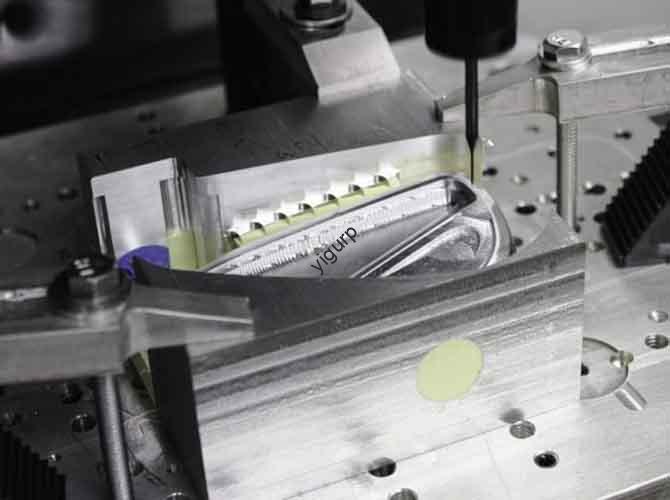Usinage CNC est devenu l'épine dorsale de la fabrication de précision, mais comment atteindre systématiquement ces objectifs de tolérance stricts? Que vous produisiez des pièces médicales ou des composants aérospatiaux, Précision d'usinage CNC directly impacts product performance and customer trust. Cet article détaille les facteurs critiques affectant la précision, solutions pratiques, et des benchmarks réels pour vous aider à optimiser votre processus.
1. Facteurs fondamentaux affectant la précision de l'usinage CNC: Un tableau comparatif
Tous les problèmes de précision ne proviennent pas de la même source. Ci-dessous, un aperçu côte à côte en haut 6 facteurs, leur impact, et des solutions rapides:
| Facteur | Impact sur la précision | Conseils d'optimisation rapides |
|---|---|---|
| Qualité des machines | Haut (30-40% d'erreurs) | Choisissez des machines avec des châssis en fonte rigide |
| Qualité des outils | Haut (25-30% d'erreurs) | Utiliser des outils en carbure; remplacer après 50 heures d'utilisation |
| Contrôle de la température | Moyen (15-20% d'erreurs) | Maintain shop temp at 20-22°C (± 1 ° C) |
| Précision de la programmation | Moyen (10-15% d'erreurs) | Test tool paths with simulation software |
| Vitesse d'usinage | Bas à moyen (5-10% d'erreurs) | Reduce speed by 10% for tolerances <0.01MM |
| Fixture Accuracy | Moyen (15-20% d'erreurs) | Use hydraulic clamps for stable clamping force |
2. Allons plus loin: Facteurs critiques expliqués
Qualité des machines: La base de la précision
A CNC machine is only as accurate as its components. High-precision machines use:
- Rigid structures: Cast iron frames reduce vibration during cutting.
- High-quality ball screws: Minimize backlash (ideal for tolerances down to 0.001mm).
- Precision linear guides: Ensure smooth, consistent movement of the spindle.
Par exemple, a mid-range CNC mill might achieve 0.01mm accuracy, while a high-end model (like those used in semiconductor manufacturing) can hit 0.001mm—10 times more precise.
Qualité des outils: Ne négligez pas l’avant-garde
Imagine using a dull pencil to draw a straight line—tools work the same way.
- Précision géométrique: A tool with uneven edges will leave rough surfaces and miss tolerance.
- Wear state: Après 8 hours of continuous cutting, a high-speed steel tool can lose up to 0.005mm of its edge—enough to ruin a part requiring 0.003mm accuracy.
Solution: Utilisercoated carbide tools (Par exemple, TiAlN coating) to extend life and check tool wear with a micrometer every 2 heures.
Contrôle de la température: Le tueur de précision caché
Why do bakeries keep ovens at a fixed temperature? Because materials expand and contract with heat—same for CNC machining.
- A 5°C temperature rise can cause a 1-meter aluminum workpiece to expand by 0.06mm (more than the typical 0.01mm tolerance!).
- Even spindle heat matters: A hot spindle can shift by 0.002mm mid-machining.
Réparer: Install HVAC systems with precise controls and usesystèmes de refroidissement to keep tools and workpieces at a steady temp.
3. Repères de précision du monde réel: Ce qui est réalisable?
How do these factors translate to actual results? Here’s a breakdown of typical accuracy levels for different industries:
| Industrie | Précision requise | Common CNC Setup |
|---|---|---|
| Automobile | 0.05-0.1MM | Mid-range CNC lathe + Outils HSS |
| Dispositifs médicaux | 0.005-0.01MM | High-precision mill + outils en carbure + temp control |
| Aérospatial | 0.001-0.005MM | Ultra-precision machine + outils en céramique + vibration dampening |
4. Le point de vue de Yigu Technology sur la précision de l'usinage CNC
À la technologie Yigu, nous croyonsaccuracy is not just a specification—it’s a process. Our CNC solutions combine rigid machine designs with intelligent temperature monitoring to reduce errors by up to 30%. We often advise clients to start with a “accuracy audit”: test their current process against the factors in this article, then prioritize fixes (Par exemple, upgrading tools before buying a new machine). Pour la plupart des fabricants, petit, targeted changes (like better fixture clamping) yield faster ROI than full overhauls.
FAQ
- Q: Can I achieve 0.001mm accuracy with a standard CNC machine?UN: Non. Standard machines typically top out at 0.01mm. Ultra-precision machines (with specialized components) are needed for 0.001mm tolerances.
- Q: How often should I calibrate my CNC machine to maintain accuracy?UN: Pour une production à volume élevé, calibrate every 3 mois. Pour les petits volumes, precision work, calibrate monthly.
- Q: Does faster machining always mean lower accuracy?UN: Pas toujours. Some modern machines use “high-speed precision” technology (Par exemple, adaptive feed rates) to maintain accuracy at faster speeds. Test with your specific part and material first.
